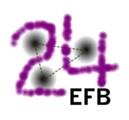Speaker
Description
The best strategy to precisely determine the energy difference between two adjacent energy levels is to perform an interferometric measurement. If the signal-to-noise ratio (SNR) is not favorable, either due to large unavoidable noise or a naturally small signal, but the signal is many oscillations long, the standard analysis takes advantage of a fast Fourier transform (FFT). What if the signal, due to inherent decay of the coherent oscillations, is not long though?
Such a short, low frequency and low SNR signal was recently obtained in a novel experimental approach to probe the energy level as well as lifetime and collision properties of Efimov trimers in ultra-cold atoms [1]. Here we demonstrate that the correct analysis to this kind of signal is based on a three-parameter (amplitude, frequency and phase) sinusoidal fit applied in the vicinity of various initial parameter values. This allows precise determination of the global minimum in parameter space. By means of randomly generated data with an SNR as low as unity, we show that a dozen or so oscillations suffice to determine the largest frequency contribution with high statistical significance. Unlike FFT, this method is hardly affected by parasite frequencies arising from the large noise.
[1] Y. Yudkin, R. Elbaz, P. Giannakeas, C. H. Greene and L. Khaykovich: A coherent superposition of Feshbach dimers and Efimov trimers (arXiv:1901.02268)
